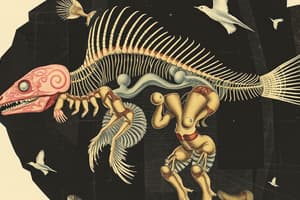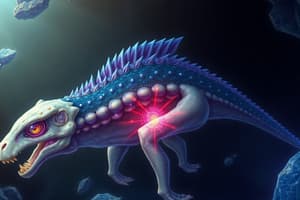Podcast
Questions and Answers
What type of body plan is exhibited by animals like annelids and arthropods?
What type of body plan is exhibited by animals like annelids and arthropods?
- Asymmetry
- Radial symmetry
- Bilateral symmetry (correct)
- Spherical symmetry
Which of the following animals are diploblastic?
Which of the following animals are diploblastic?
- Chordates
- Echinoderms
- Coelenterates (correct)
- Platyhelminthes
What is the term for the layer of cells in between the ectoderm and endoderm in diploblastic animals?
What is the term for the layer of cells in between the ectoderm and endoderm in diploblastic animals?
- Mesoglea (correct)
- Germ layer
- Mesoderm
- Coelom
Which of the following animals are triploblastic?
Which of the following animals are triploblastic?
What is the term for the body cavity lined by mesoderm?
What is the term for the body cavity lined by mesoderm?
Which of the following is a characteristic used in classification?
Which of the following is a characteristic used in classification?
Which of the following animals have a coelom?
Which of the following animals have a coelom?
What is the term for the body cavity that is not lined by mesoderm?
What is the term for the body cavity that is not lined by mesoderm?
What is the term for animals that possess a body cavity lined by mesoderm?
What is the term for animals that possess a body cavity lined by mesoderm?
Which of the following is an example of a coelomate?
Which of the following is an example of a coelomate?
What is the term for the body cavity in animals where the mesoderm is present as scattered pouches?
What is the term for the body cavity in animals where the mesoderm is present as scattered pouches?
Which of the following is characterized by the presence of a notochord?
Which of the following is characterized by the presence of a notochord?
What is the term for the phenomenon of serial repetition of organs in some animals?
What is the term for the phenomenon of serial repetition of organs in some animals?
Which of the following is an example of an acoelomate?
Which of the following is an example of an acoelomate?
What is the term for the body cavity in animals where the mesoderm is absent?
What is the term for the body cavity in animals where the mesoderm is absent?
Which of the following groups of animals exhibit triploblastic organisation?
Which of the following groups of animals exhibit triploblastic organisation?
Which of the following phyla exhibits bilateral symmetry?
Which of the following phyla exhibits bilateral symmetry?
What is the characteristic of the coelom in the phylum Annelida?
What is the characteristic of the coelom in the phylum Annelida?
Which of the following phyla exhibits triploblastic organisation?
Which of the following phyla exhibits triploblastic organisation?
What is the characteristic of the digestive system in the phylum Cnidaria?
What is the characteristic of the digestive system in the phylum Cnidaria?
Which of the following phyla exhibits diploblastic organisation?
Which of the following phyla exhibits diploblastic organisation?
What is the characteristic of the coelom in the phylum Aschelminthes?
What is the characteristic of the coelom in the phylum Aschelminthes?
Which of the following phyla exhibits pseudocoelomate organisation?
Which of the following phyla exhibits pseudocoelomate organisation?
What is the characteristic of the body organisation in the phylum Annelida?
What is the characteristic of the body organisation in the phylum Annelida?
Flashcards
Coelomates
Coelomates
Animals with a body cavity lined by mesoderm.
Pseudocoelomates
Pseudocoelomates
Animals with a body cavity not fully lined by mesoderm; mesoderm present as scattered pouches.
Acoelomates
Acoelomates
Animals without a body cavity.
Metameric segmentation
Metameric segmentation
Signup and view all the flashcards
Metamerism
Metamerism
Signup and view all the flashcards
Notochord
Notochord
Signup and view all the flashcards
Chordates
Chordates
Signup and view all the flashcards
Non-chordates
Non-chordates
Signup and view all the flashcards
Bilateral symmetry
Bilateral symmetry
Signup and view all the flashcards
Radial symmetry
Radial symmetry
Signup and view all the flashcards
Diploblastic organization
Diploblastic organization
Signup and view all the flashcards
Triploblastic organization
Triploblastic organization
Signup and view all the flashcards
Coelom
Coelom
Signup and view all the flashcards
Porifera characteristics
Porifera characteristics
Signup and view all the flashcards
Coelenterata (Cnidaria) characteristics
Coelenterata (Cnidaria) characteristics
Signup and view all the flashcards
Ctenophora characteristics
Ctenophora characteristics
Signup and view all the flashcards
Platyhelminthes characteristics
Platyhelminthes characteristics
Signup and view all the flashcards
Aschelminthes characteristics
Aschelminthes characteristics
Signup and view all the flashcards
Annelida characteristics
Annelida characteristics
Signup and view all the flashcards
Study Notes
Body Organization
- Coelomates: animals with a body cavity lined by mesoderm, e.g., annelids, molluscs, arthropods, echinoderms, hemichordates, and chordates.
- Pseudocoelomates: animals with a body cavity not lined by mesoderm, but instead, mesoderm is present as scattered pouches between ectoderm and endoderm, e.g., aschelminthes.
- Acoelomates: animals without a body cavity, e.g., platyhelminthes.
Segmentation
- Metameric segmentation: the body is externally and internally divided into segments with a serial repetition of at least some organs, e.g., earthworm.
- Metamerism: the phenomenon of serial repetition of organs.
Notochord
- Notochord: a mesodermally derived rod-like structure formed on the dorsal side during embryonic development in some animals.
- Chordates: animals with a notochord, e.g., some animals from embryonic development.
- Non-chordates: animals without a notochord, e.g., porifera to echinoderms.
Body Symmetry
- Bilateral symmetry: the body can be divided into identical left and right halves in only one plane, e.g., annelids, arthropods.
- Radial symmetry: the body can be divided into identical parts around a central axis, e.g., coelenterates, ctenophores, and echinoderms.
Germinal Layers
- Diploblastic organization: animals with two embryonic layers, an external ectoderm and an internal endoderm, e.g., coelenterates.
- Triploblastic organization: animals with three germinal layers, an external ectoderm, an internal endoderm, and a mesoderm in between, e.g., platyhelminthes to chordates.
Coelom
- Coelom: a body cavity lined by mesoderm, present in some animals, e.g., annelids, molluscs, arthropods, echinoderms, hemichordates, and chordates.
Phylum Characteristics
- Porifera: cellular organization, absent symmetry, absent coelom, absent segmentation, and absent digestive, circulatory, and respiratory systems.
- Coelenterata (Cnidaria): tissue organization, radial symmetry, absent coelom, absent segmentation, and incomplete digestive system.
- Ctenophora: tissue organization, radial symmetry, absent coelom, absent segmentation, and incomplete digestive system.
- Platyhelminthes: organ organization, bilateral symmetry, absent coelom, absent segmentation, and incomplete digestive system.
- Aschelminthes: organ organization, bilateral symmetry, pseudocoelomate, absent segmentation, and complete digestive system.
- Annelida: organ organization, bilateral symmetry, coelomate, present segmentation, and complete digestive system.
Studying That Suits You
Use AI to generate personalized quizzes and flashcards to suit your learning preferences.




